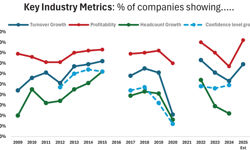The magazine industry suffered a deeper decline than of late during this period, with some interesting and clear trends within the figures.
Celebrity weeklies
The celebrity weeklies sector is largely responsible for the slump, with severe declines across nearly all titles. This is despite heavy marketing investment from all publishers. The already widespread use of multi-bagging is increasing further still, with two routes being followed. One is to multi-bag nearly the full print run over a limited number of issues in the period. For instance, Heat implemented this across five issues in the period, an increase from two issues the previous year. Other titles instead prefer to multi-bag more issues but with a lower percentage of the print run. OK! multi-bagged around 60% of the prints runs across 19 issues, up from eleven in the previous period. All titles have utilised one of these approaches, or as in the case with Now, a combination of the two. Northern & Shell and Bauer further bolstered their marketing investment with significant levels of above-the-line advertising spend; OK! benefited most with a near doubling of spend to an NMR-reported £2m over the period.
Considering such concerted efforts to market the titles to consumers, it is telling that all but one title – Hello – lost circulation and more than half of the titles in the sector were hit with a double-digital percentage decrease. This suggests that the level of reader interest in the cult of celebrity is falling short of that required to sustain such a competitive and cluttered magazine marketplace. That Channel 4 decided to remove Big Brother from its schedule supports this. As a result, there is no margin for error or complacency, either in editorial development or the marketing of the product.
With that in mind, that Now was without an editor since Abigale Blackburn left last summer is sure to have contributed to its 20% circulation fall. This was the worst performance in the sector; if a magazine is a ship, then its captain is the editor and good navigation skills with a steady hand on the tiller are required to guide it through the stormy waters of an uncertain marketplace. Heat’s editor Sam Delaney announced his departure in December; while Lucie Cave has stepped up as acting editor, Bauer would be wise to confirm a full editorship appointment as soon as possible.
Real life weeklies
Another sector to suffer in the latest figures is the real life weeklies, which continues its decline. Its readers are likewise suffering in the recession and these titles with their tales of drama and misery do little to cheer them up. The travel sector, in contrast, provides a welcome source of escapism, and with overseas travel down 5% last year, it clearly matters little whether the thought of travel itself is fantasy or reality. This marketplace is both focused and uncluttered. Its clear and welcome proposition means it is little wonder that not only do two out of the sector’s three titles boast circulation increases in excess of 20%, but two also benefit from some of the highest subscription bases in the magazine marketplace. Lonely Planet and Condé Nast Traveller enjoy subscription sales of 58% and 62% of their UK actively purchased circulations respectively; their readers obviously feel that the titles offer them such good quality content that they cannot easily get elsewhere that they are happy to make the commitment.
Home interest sector
The home interest sector offers a similarly escapist read for some, albeit in a far more congested marketplace and one that struggles with differentiation between the brands. However, it is testament to the strength of the sector and its popularity amongst consumers that not only has it enjoyed growth of 5.5% in total, but the performance has been relatively consistent across its fourteen titles. The majority of titles are either flat or register modest increases, and only two slip between 2% and 4% year-on-year. Unlike the celebrity weeklies, this is one sector that continues to prove its relevance to consumers and maintain its place in their media consumption. The same can be said of the women’s fashion titles, which continue to provide readers with a unique proposition which is not represented anywhere nearly as effectively or aspirationally on other platforms. It is clear from the long term stability of their circulations that they know their natural market sizes, and quietly make efforts to hold or slowly grow their positions through continued editorial excellence and integrity. Titles offer the readers added-value in the form of editorial supplements, or targeted cover-mounted beauty gifts which make a statement about the magazine’s positioning.
Attracting the young
Whilst the fashion titles stay strong by offering readers what cannot be found elsewhere, that the younger mainstream women’s lifestyle monthlies are unable to deliver in this area is one of the reasons why they are struggling. The broad appeal mix of features, interviews, relationships, beauty, mainstream fashion and entertainment editorial is ubiquitous; online, in free magazines, newspapers and their supplements - with such choice readers will question why they should pay for it, and magazines that do not clearly add value or differentiate themselves will fail. Also, perhaps, we are seeing the wave of teenagers who deserted magazines in droves to decimate the teen market, start to grow up and turn their noses up at the monthlies to instead reach for their iPhones. This might help explain why it is the younger brands such as Company and Cosmopolitan which experienced the greatest declines. Cosmopolitan recognised this threat and have responded by launching Cosmo On Campus, publishing an issue at the start of each university term and distributing them free to students. This is a clever move and will help establish their relevance amongst an audience which might view magazines as irrelevant. It would be easy to be distracted by other more short-termist measures; future-proofing the Cosmo brand is a wise move. To ignore this would surely mean going the way of Sugar, which closed its doors as a print publication in order to focus on its blossoming web portal www.sugarscape.com.
NME also followed this route in printing 50k extra copies of their “Ones (bands) to watch” issue which were distributed free of charge at university campuses. The music sector is particularly threatened by the web. Websites and blogs are better able to make use of technology, even offering to “mash up” and integrate offerings with music streaming sites such as Spotify. It is a challenge for magazines to differentiate and add value. The stronger paid-for brands such as NME and Q achieve this by hosting exclusive live gigs and offering their readers access to the rock stars they worship. Free title and market leader, The Fly, is itself closely connected to the live music scene via its parent company MAMA Group, which owns live music venues as well as artist management companies.
Some magazines have trialled regionally targeted content in an attempt to replicate the personalisation and relevance offered by the internet. Glamour produced eight bespoke regional issues in September, while Good Housekeeping produced a North West edition for their December issue. Whether this can be sustained at a level that makes a difference remains to be seen, but certainly these are positive moves to make and other publishers should note the innovation.
And not forgetting the iPad…
More future-facing moves live in the form of the iPad app. Many publishers are sure to have invested considerable product development and marketing budgets into the internet in recent years, only to struggle to make a return on the investment. It would therefore be understandable if there were a reticence in committing to further investment in iPad applications. The iPad itself launched only last May in the UK, and there is neither the insight into the consumer experience nor the marketplace penetration to offer publishers real confidence that investment will lead to reward. It is therefore reassuring to see that, despite this, at least fifteen magazine iPad apps will have launched by the time you read this. Some are regular monthly paid-for apps, others are free or one-offs. The tech-magazines are a key component as you would expect – nearly a third of MacUser’s circulation is now via the iPad. Titles such as Empire clearly lean towards the audio-visual benefits of the technology, and men’s iPad-only magazine Project launched providing a fabulously enriched and engaging consumption experience. iPad apps are not just restricted to the early adopter audiences; magazines such as BBC Good Food and Reader’s Digest are also getting in on the act and I am sure will obtain valuable experience and insights from these early attempts. This is sure to be budget well spent with the future in mind.
It is clear then that while some sectors are suffering from waning reader interest in the subject matter, other sectors remain steady or even buoyant as magazines continue to deliver desirable unique content and remain relevant to the audience. Aggressive marketing tactics are being implemented, and editorial quality and innovation continue to be at a high standard. The magazine industry remains on solid foundations and it’s good to see there is the will, the vision and the budget to take it into the future.










